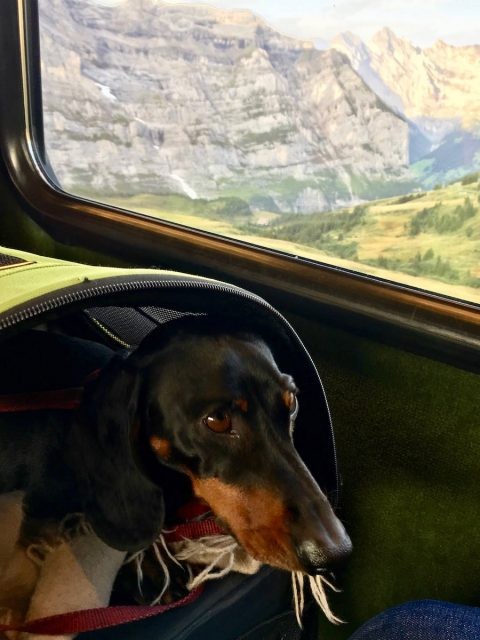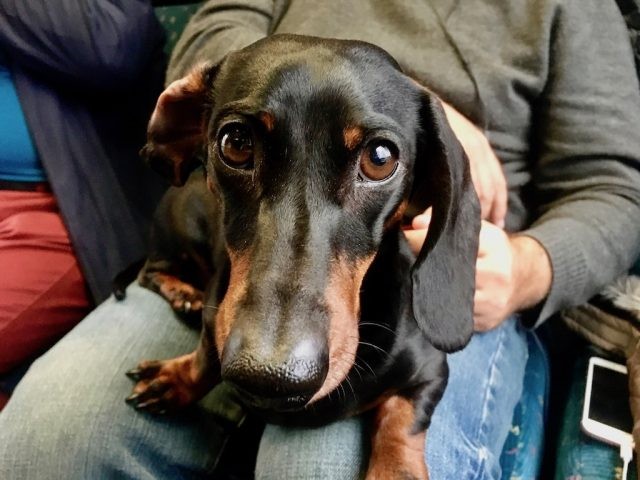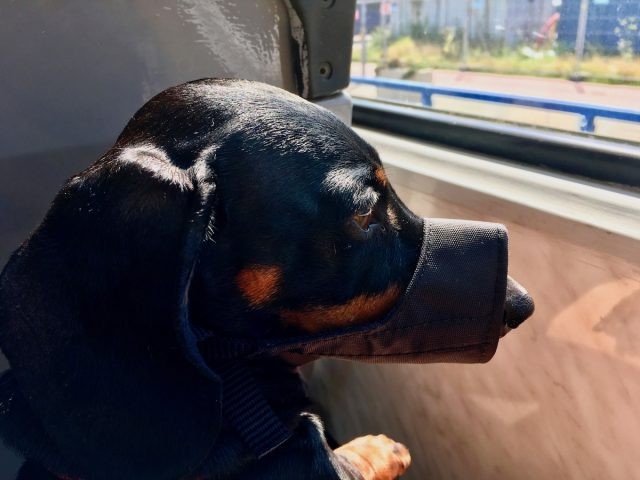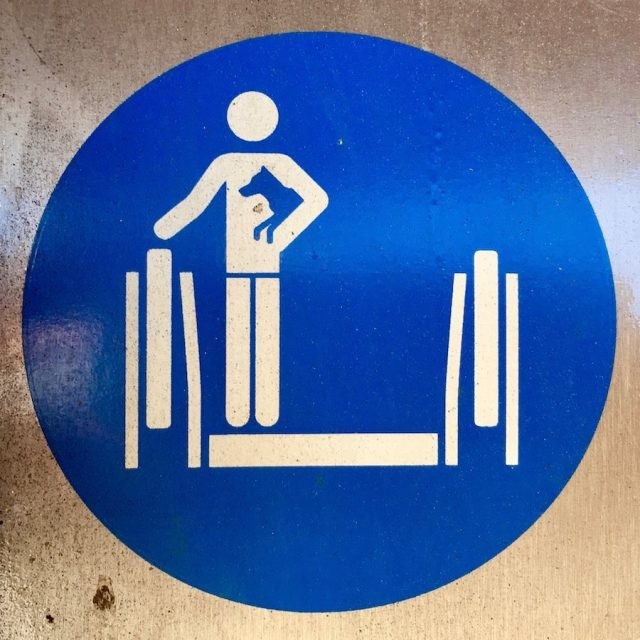Are you planning a European adventure and wondering, “Can Dogs Travel On Trains In Europe?” Absolutely! With TRAVELS.EDU.VN, discover how easy and enjoyable it is to explore Europe with your furry friend by train. We’ll guide you through pet-friendly train routes, regulations, and essential tips for a seamless journey, ensuring a memorable experience for both you and your canine companion. Unlock the secrets to stress-free pet travel with our expert advice on European train travel, pet train policies, and dog-friendly travel tips.
1. Which European Trains Welcome Dogs?
Most European train services allow dogs, but there are exceptions. Before planning your trip, it’s essential to know which trains accommodate dogs of all sizes.
- Eurostar: Unfortunately, Eurostar, connecting London to Paris and Brussels, generally does not allow pet dogs, making it a notable exception.
- Eurostar Sun and Eurostar Snow: These seasonal services, previously operated by Thalys and now by Eurostar, also do not permit dogs.
- Pet-Friendly Trains: Most other train services across Europe welcome dogs, allowing you to travel comfortably with your pet.
Always verify the specific pet policies of each train service before booking to avoid any surprises.
 Eurostar in London, dogs not allowed
Eurostar in London, dogs not allowed
2. Which European Trains Impose Size Restrictions for Dogs?
While many trains in Europe are dog-friendly, some countries have restrictions based on the size of the dog. It’s crucial to be aware of these rules to ensure your travel plans go smoothly.
Restrictions for Larger Dogs on Trains in Spain
Until recently, Spain’s RENFE trains only allowed small pets (under 10kg in a carrier). However, since 2022, they have expanded their policy on select AVE high-speed trains to allow larger dogs (up to 40kg) on routes such as Madrid to Barcelona, Madrid to Malaga, Madrid to Alicante, Madrid to Valencia, Madrid to Zaragoza and Madrid to Granada. A maximum of one or two dogs are allowed per train, and you need to book your dog online, arrive 40 minutes early for paperwork, and receive a travel kit.
Larger dogs are permitted on Cercanías (Commuter) services with no weight limit, provided they are leashed and muzzled. This policy extends to Portugal, except for international trains traveling through Spain.
Quick Guide to Dog Travel on Spanish Trains
| Train Type | Dog Size Limit | Requirements | Routes |
|---|---|---|---|
| AVE (Selected High-Speed) | Up to 40kg | Online booking, arrive 40 mins early, travel kit provided, adjoining seat required | Madrid to Barcelona, Madrid to Malaga, Madrid to Alicante, Madrid to Valencia, Madrid to Zaragoza, Madrid to Granada |
| Cercanías (Commuter) | No Limit | Leash and muzzle required | All routes |
| Other AVE, Larga Distancia, Avant, Media Distancia | Over 10kg | Not Allowed | N/A |
Restrictions for Larger Dogs on Trains in Greece
In Greece, Hellenic Train allows larger dogs only on specific routes like Athens to Thessaloniki and Thessaloniki to Lianokladi, where there is a luggage transport coach. Only two dogs are allowed per train, and they must travel in a pet transport box (up to 118 x 76 x 88cm) in the ventilated luggage coach.
Restrictions for Larger Dogs on Trains in Slovenia
Slovenia, generally dog-friendly, prohibits large dogs (over 30cm in height) on InterCity Slovenia (ICS) tilting trains due to limited space. However, large dogs are allowed on other trains.
Restrictions for Larger Dogs on Trains in Ireland
In Ireland, Irish Rail generally does not allow larger dogs, except on inter-city trains between Dublin and Cork, and Dublin and Belfast. On these routes, larger dogs can travel in the guard vans but not in passenger carriages.
 Thessaloniki dog-friendly trains
Thessaloniki dog-friendly trains
3. Which European Countries Welcome Dogs on Trains?
Many European countries welcome dogs on their trains, making it easier to explore with your furry friend. These countries generally allow both large and small dogs in regular passenger carriages.
- Austria
- Belgium
- Czech Republic
- Denmark
- Finland
- France
- Germany
- Hungary
- Italy
- Luxembourg
- Netherlands
- Norway
- Poland
- Portugal
- Romania
- Slovakia
- Sweden
- Switzerland
Important Considerations
- Specific Carriages/Areas: In some countries, dogs may only be allowed in specific carriages or areas.
- First Class Restrictions: Dogs are often not allowed in first-class carriages.
- Scandinavian Countries: Denmark, Norway, and Sweden have designated areas for dogs on trains.
- Passenger Approval: In a few countries, you might need to ask permission from nearby passengers or move if someone objects.
 Dog friendly european train
Dog friendly european train
4. What Are The Standard Rules For Dogs On European Trains?
The rules for dogs on trains across Europe are generally similar, with distinctions between small and large dogs.
Rules for Small Dogs
- Carriers: Small dogs traveling in a carrier generally travel for free.
- Exceptions: France charges a small fee (around €7), and some premium services may also have a fee.
- Lap Travel: Some countries allow small dogs to travel on your lap without a carrier, often for free.
Rules for Larger Dogs
- Fares: Larger dogs typically require a half-price or child’s fare.
- Dog-Specific Tickets: Some ticket machines offer dog-specific tickets.
- Leashes and Muzzles: Most countries require larger dogs to be leashed, and many require muzzles.
Detailed Overview of Dog Travel Rules
| Rule | Small Dogs (In Carrier) | Small Dogs (On Lap) | Large Dogs (Leashed) | Large Dogs (Muzzled) |
|---|---|---|---|---|
| Fare | Free | Free | Half-Price/Child Fare | Half-Price/Child Fare |
| Carrier Required | Yes | No | No | No |
| Leash Required | No | No | Yes | Yes |
| Muzzle Required | No | No | Varies | Varies |
Additional Notes
- Metropolitan Trains: Some metropolitan trains allow all dogs to travel for free.
- Netherlands: Domestic trains offer a cheap “dog ticket” for around €3.30 per day.
- Check my guide to muzzles in Europe for which countries do and don’t require muzzles on public transport.
 Dog on train lap
Dog on train lap
5. Are Dogs Permitted In First Class & Sleeper Carriages?
Regulations regarding dogs in first-class and sleeper carriages vary by country.
First Class Carriages
- Restrictions: Some countries prohibit dogs (or larger dogs) in first class.
- Permissions: Other countries allow dogs, but their ticket remains a second-class, half-price fare.
Sleeper Carriages
- Prohibitions: Dogs may sometimes be prohibited in sleeper carriages.
- Compartment Booking: You may need to book the entire compartment for you and your dog.
- Dining Carriages: Dogs are typically not allowed in dining carriages.
General Rules for All Dogs
- Seating: Dogs are generally prohibited from sitting on seats.
- Cleanliness: Always clean up after your dog.
Always check the specific rules for each train service and country before traveling.
 Best dog muzzles
Best dog muzzles
6. What Are Essential Tips For Train Travel In Europe With Your Dog?
Traveling by train in Europe with your dog can be a fantastic experience with the right preparation. Here are essential tips to ensure a smooth and enjoyable journey.
Preparation and Acclimation
- Start with Shorter Journeys: If your dog is new to train travel, begin with short trips to acclimate them to the experience.
- Plan for Breaks: Avoid long journeys unless your dog can hold on or there are long stops for breaks.
- Arrive Early: Allow extra time at the departure station, especially if you need to buy a ticket for your dog.
Safety and Comfort
- Escalator Safety: Carry small dogs on escalators and use stairs for larger dogs.
- Seating: Choose a quiet spot away from other passengers and dogs, if possible.
- Muzzle Preparedness: Always carry a muzzle, even if you don’t typically use one.
Practical Considerations
- Toilet Breaks: Prioritize a toilet break for your dog immediately upon arrival.
- Essentials: Pack water, bowls, food, and waste bags.
- Health Documents: Ensure you have all necessary health certificates and vaccination records.
- First-Aid Kit: Include pet-specific items.
- Comfort Items: A familiar blanket or toy can reduce stress.
Detailed Checklist for Dog Train Travel
| Item | Description |
|---|---|
| Pet Carrier | Essential for small dogs; ensures comfort and safety. |
| Leash and Harness | Necessary for controlling your dog in stations and on trains. |
| Muzzle | Required in some countries; ensure it fits properly and is comfortable. |
| Water and Food | Pack enough for the journey; collapsible bowls are convenient. |
| Waste Bags | Always clean up after your dog; be a responsible pet owner. |
| Health Certificates | Keep copies of vaccination records and health certificates. |
| First-Aid Kit | Include antiseptic wipes, bandages, and any necessary medications. |
| Comfort Items | A familiar blanket or toy can help reduce stress and anxiety. |
Real-Life Scenario: Navigating a Train Journey with Your Dog
Imagine you’re traveling from Paris to Berlin with your dog, Max. Here’s how these tips come into play:
- Preparation: Knowing that Max is new to long train rides, you start with shorter trips around Paris to get him used to the train.
- Arrival: You arrive at Gare du Nord an hour early to purchase Max’s ticket and find a comfortable spot.
- Boarding: You carry Max, who is small, onto the train to avoid the escalator.
- Seating: You find a quiet compartment away from other passengers.
- Comfort: You place Max’s blanket on the floor, and he settles down for a nap.
- Muzzle: Although not required, you keep a muzzle handy in case the conductor asks.
- Breaks: During a long stop in Frankfurt, you take Max for a quick walk to stretch his legs and relieve himself.
- Arrival: In Berlin, the first thing you do is take Max outside for a proper toilet break.
How TRAVELS.EDU.VN Can Help
TRAVELS.EDU.VN offers tailored advice for traveling with your dog on European trains. We provide detailed information on pet-friendly routes, specific train regulations, and tips to ensure a comfortable and stress-free journey.
- Personalized Planning: We help you create a customized itinerary that considers your dog’s needs.
- Up-to-Date Information: Access the latest pet policies for various European train services.
- Expert Support: Our team offers guidance and answers to all your questions about traveling with your dog.
With TRAVELS.EDU.VN, you can confidently embark on a European train adventure with your beloved canine companion, knowing every detail is taken care of.
 Dog on escalator
Dog on escalator
7. How Can TRAVELS.EDU.VN Enhance Your Dog-Friendly European Train Trip?
TRAVELS.EDU.VN goes beyond providing basic information, offering comprehensive services to make your dog-friendly European train trip exceptional.
- Personalized Itineraries: Tailored travel plans that cater to your specific needs and preferences.
- Pet-Friendly Accommodation: Recommendations for hotels and rentals that welcome pets.
- Activity Suggestions: Ideas for dog-friendly activities at your destinations.
- Emergency Support: Assistance during your trip.
Why Choose TRAVELS.EDU.VN?
- Expertise: Extensive knowledge of dog-friendly travel.
- Convenience: Streamlined planning process.
- Peace of Mind: Knowing every detail is taken care of.
Contact TRAVELS.EDU.VN today to start planning your unforgettable European train adventure with your dog!
Benefits of Using TRAVELS.EDU.VN
- Save Time: Avoid the hassle of researching and planning.
- Reduce Stress: Enjoy a smooth and worry-free trip.
- Create Memories: Focus on enjoying your time with your dog.
- Customized Support: Benefit from personalized assistance and expert advice.
TRAVELS.EDU.VN ensures a seamless and enjoyable travel experience, allowing you to fully appreciate the beauty of Europe with your dog.
8. Understanding The Legal Necessities For Dog Travel In Europe
Traveling with your dog in Europe involves adhering to specific legal requirements to ensure smooth passage across borders. These regulations primarily focus on pet identification, vaccinations, and health documentation.
Key Legal Requirements
-
Microchipping:
- Requirement: Dogs must have a microchip for identification. The microchip should comply with ISO standards 11784 and 11785.
- Purpose: The microchip links your dog to its records, including vaccination history and owner information.
-
Rabies Vaccination:
- Requirement: A valid rabies vaccination is essential. The initial vaccination must be administered at least 21 days before travel.
- Purpose: Rabies vaccination protects both your dog and the public from this deadly virus. Booster shots must be kept up-to-date.
-
EU Pet Passport:
- Requirement: An EU Pet Passport is necessary for dogs traveling from one EU country to another. It contains details of microchipping and rabies vaccination.
- Purpose: The pet passport provides a standardized record of your dog’s health and vaccination history.
-
Animal Health Certificate (AHC):
- Requirement: If you’re entering the EU from a non-EU country, you’ll need an Animal Health Certificate (AHC).
- Purpose: The AHC confirms your dog meets the EU’s health requirements for entry. It must be issued by an official veterinarian in the country of origin no more than ten days before arrival in the EU.
-
Tapeworm Treatment:
- Requirement: Some countries require tapeworm treatment (usually praziquantel) administered by a veterinarian 1-5 days before entering the country.
- Purpose: Prevents the spread of tapeworm, protecting local animal populations.
-
Documentation Checklist:
- Microchip information
- Rabies vaccination certificate
- EU Pet Passport or AHC
- Tapeworm treatment record (if required)
- Any other health certificates specific to the countries you plan to visit
Country-Specific Regulations
Each European country may have additional requirements. Always check the specific regulations for the countries you plan to visit. Resources include:
- Government Websites: Official government websites for pet travel information.
- Veterinary Advice: Consult your veterinarian for the most current and relevant advice.
- EU Official Website: The official website of the European Union.
By adhering to these legal requirements, you ensure a safe and stress-free journey for you and your dog in Europe. Failure to comply can result in quarantine or refusal of entry.
9. What Are The Best Dog-Friendly Routes In Europe By Train?
Selecting the right train routes can significantly enhance your travel experience with your dog. Here are some of the best dog-friendly train routes in Europe, offering comfort, convenience, and beautiful scenery.
-
Germany:
-
Route: Munich to Berlin
- Known for its efficiency and comfort, Deutsche Bahn (DB) welcomes dogs on most trains. Enjoy the scenic views as you travel between these two iconic cities.
-
-
Switzerland:
-
Route: Zurich to Interlaken
- Swiss trains are renowned for their punctuality and stunning landscapes. This route offers breathtaking views of the Swiss Alps, making it a memorable journey for you and your dog.
-
-
Austria:
-
Route: Vienna to Salzburg
- ÖBB (Austrian Federal Railways) is dog-friendly and efficient. This route connects two of Austria’s most beautiful cities, offering a mix of cultural and natural attractions.
-
-
France:
-
Route: Paris to Nice
- SNCF (French National Railway Company) allows dogs on most trains. This route takes you from the bustling capital to the sunny French Riviera, offering a diverse range of experiences.
-
-
Italy:
-
Route: Rome to Florence
- Trenitalia welcomes dogs on their trains, making it easy to travel between these historic cities. Enjoy the picturesque landscapes of Tuscany along the way.
-
-
Netherlands:
-
Route: Amsterdam to Rotterdam
- NS (Dutch Railways) offers convenient and dog-friendly train services. This route connects two of the Netherlands’ major cities, known for their modern architecture and vibrant cultural scene.
-
-
Spain:
-
Route: Madrid to Barcelona
- RENFE (Spanish National Railway Company) has expanded its pet policy on selected AVE high-speed trains. This route allows larger dogs (up to 40kg) on these routes, making it easier to travel between Spain’s two largest cities. Enjoy the comfort and speed of the AVE train as you traverse the Spanish countryside.
-
Route Details and Highlights
| Route | Country | Train Operator | Highlights |
|---|---|---|---|
| Munich to Berlin | Germany | Deutsche Bahn | Efficient travel between two iconic cities, scenic views |
| Zurich to Interlaken | Switzerland | Swiss Federal Railways | Punctual, stunning views of the Swiss Alps |
| Vienna to Salzburg | Austria | ÖBB | Connects two of Austria’s most beautiful cities |
| Paris to Nice | France | SNCF | From the capital to the French Riviera, diverse experiences |
| Rome to Florence | Italy | Trenitalia | Picturesque landscapes of Tuscany |
| Amsterdam to Rotterdam | Netherlands | NS | Connects two major cities, modern architecture and vibrant cultural scene |
| Madrid to Barcelona | Spain | RENFE | High-speed travel, comfort, Spanish countryside (Larger dogs up to 40kg are allowed on AVE high-speed trains on the Madrid to Barcelona route. Check for updated routes with Renfe) |
Preparation Tips for Route Planning
- Check Pet Policies: Always verify the latest pet policies for each train operator.
- Book in Advance: Reserve tickets, especially for popular routes.
- Consider Travel Time: Choose routes that suit your dog’s comfort and needs.
- Plan Breaks: Look for routes with longer stops for toilet breaks.
These dog-friendly train routes offer a blend of convenience, comfort, and scenic beauty, ensuring a memorable travel experience for you and your furry friend.
10. What Are Some Common FAQs About Dogs Traveling On Trains In Europe?
1. Are dogs allowed on trains in Europe?
Yes, most European train services allow dogs, but there are exceptions like Eurostar. Always check the specific pet policies of each train service before booking.
2. Do I need a special ticket for my dog?
Yes, larger dogs typically require a half-price or child’s fare. Small dogs in carriers often travel for free. Some train machines have dog-specific tickets.
3. Are there size restrictions for dogs on European trains?
Yes, some countries like Spain, Greece, Slovenia, and Ireland have size restrictions. Check specific country guidelines.
4. Is a muzzle required for my dog on European trains?
Many countries require larger dogs to be leashed, and some require muzzles. Check country-specific regulations.
5. Can my dog travel in first class or sleeper carriages?
Rules vary by country. Some prohibit dogs in first class, while others allow them with a second-class fare. Sleeper carriage rules also vary; you may need to book the entire compartment. Dogs are usually not allowed in dining carriages.
6. What documents do I need to travel with my dog in Europe?
You typically need a microchip, valid rabies vaccination, EU Pet Passport or Animal Health Certificate (AHC), and possibly tapeworm treatment records.
7. What should I pack for my dog when traveling on European trains?
Pack a pet carrier (for small dogs), leash, harness, muzzle (if required), water, food, bowls, waste bags, health certificates, and a first-aid kit.
8. How can I ensure my dog is comfortable during the train journey?
Start with shorter journeys, plan for breaks, choose a quiet spot, carry familiar items like a blanket, and provide water and food.
9. Are there specific rules about where my dog can sit on the train?
Dogs are generally prohibited from sitting on seats.
10. What if my dog has an accident on the train?
Always clean up after your dog. Carry waste bags and cleaning supplies.
Ready to embark on a dog-friendly European adventure? Contact TRAVELS.EDU.VN at 123 Main St, Napa, CA 94559, United States or Whatsapp: +1 (707) 257-5400. Let us help you plan a seamless and unforgettable journey for you and your furry friend! Visit our website travels.edu.vn for more information.